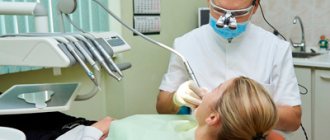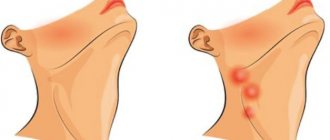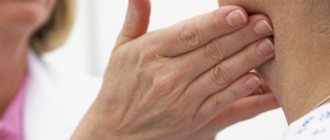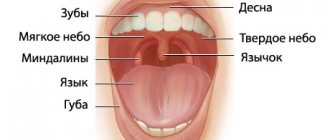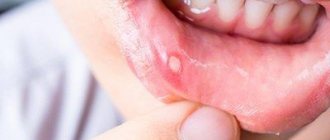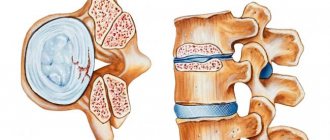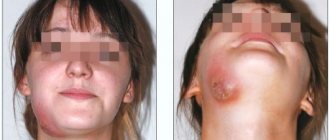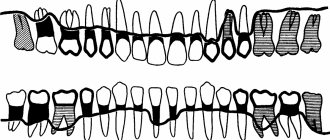General information
The organs of the lymphatic system play a protective role in the human body. They serve as a barrier to viruses, bacteria, and also filter out harmful substances. In total, there are more than 450 lymph nodes in the adult body, and their maximum number is formed by the age of 10.
Lymph nodes are connected by lymphatic vessels - lymph (a fluid with a high content of lymphocytes, or “white blood cells”) circulates through them. Produced in the bone marrow, lymphocytes circulate throughout the body, first passing through the spleen and then the lymph nodes. Thanks to this, they gain the ability to produce antibodies to destroy microbes. Source: A.G. Rumyantsev, professor, V.M. Chernov, professor, V.M. Delyagin, professor Enlarged lymph node syndrome as a pediatric problem Practical Medicine, 2007, No. 5 (24), pp. 12-15
When an infection enters , a kind of “attack” is carried out on it, as a result of which the lymph nodes can enlarge (during this period they more actively produce antibodies). After recovery, the nodes return to normal size. If their diameter and density do not return to their original state, the child must be shown to a doctor.
Function of the lymphatic system
The lymphatic system works closely with the circulatory system. With the help of a network of capillaries, vessels and nodes of the lymphatic system, various substances that are not able to penetrate the walls of blood vessels enter the blood.
So, before new particles enter the bloodstream, they are “tested” by the lymphatic system. If a certain element turns out to be potentially dangerous, it will be attacked by lymphocytes.
This filtration occurs precisely in the lymph nodes, where particles are brought with the lymph flow from the surrounding tissues. There are several types of lymphocytes in the human body and they all perform their function in protecting the body.
Lymph nodes are located in groups. They take on the task of protecting nearby tissues and organs.
What are the submandibular lymph nodes responsible for?
Lymph nodes on the lower jaw collect fluid from the intercellular space of nearby tissues and filter it. All infections that enter them are destroyed, provided that the person’s immune system works adequately. Cell waste products and decay products are also filtered out.
Important: one of the important tasks of the lymph nodes is the fight against cancer cells.
In the lymph nodes, new lymphocytes are produced and matured, which will fight infection in this area. Also in the lymphatic system of this area, harmful substances circulate from the blood to the lymph, and beneficial and nutrients are transferred from the lymph to the blood.
The correct functioning of the nodes in the lower part of the face is very important, because they have to deal with common diseases.
The most common diseases that lymphocytes of the submandibular space have to fight:
| Respiratory diseases | Oral diseases | Dental and gum diseases | Diseases of bones and joints |
| Tonsillitis | Stomatitis | Gingivitis | Inflammatory processes of the bone structures of the jaw |
| Laryngitis | Inflammation of the salivary glands | Periodontitis | Inflammatory conditions of the temporomandibular joint |
| Rhinitis | Advanced caries, often with multiple foci | ||
| Pulpitis |
Important: submandibular nodes can become inflamed as an independent phenomenon, without a primary extraneous factor.
Location of submandibular nodes
Submandibular lymph nodes, location and proximity to other lymph nodes
Lymph nodes on the jaw, that is, local formations of lymphatic tissue, are located along the path of the vessels of the lymphatic system, parallel to the course of the blood vessels. There are six to eight lymph nodes in the submandibular space.
They are located in a triangular zone under the lower jaw, slightly in front of the salivary gland, as well as in the thickness of its tissue. Lymph nodes surround the facial vein, located in front and behind it.
Vessels with lymph tend to the node from the following parts of the face:
- from the skin of the upper and lower lips;
- from the neck;
- from the chin and cheeks;
- from the outer part of the nose and its internal space;
- from the inner surface of the lower eyelid;
- from teeth, gums and palate;
- from the tongue and sublingual space;
- from all salivary glands;
- from the submandibular lymph nodes.
The video in this article and photos will clearly demonstrate which lymph nodes are responsible for which organs and tissues of the human body.
External features of nodes
Diagram of the structure of a lymph node
The lymph node in the jaw is a bean-shaped collection of lymphatic tissue. The nodes have different sizes.
In normal condition, the node has the following characteristics:
- it is soft to the touch;
- does not cause pain when touched;
- a normal size does not prevent the head from lowering to the chest, and the nodes are not felt;
- visually, the submandibular lymph nodes are not visible under the skin.
The lymphatic tissue itself is pink-gray in color. The nodes are arranged in groups and covered with a protective capsule of connective tissue.
Important: in the absence of acute inflammation in the surrounding tissues, only one, the largest submandibular node can be felt.
Lymph enters the node through incoming vessels - the gate, which is a hole on the upper part of the protective capsule. Along with the lymph flow, nerve fibers enter the node. Purified lymph exits through the efferent vessels.
The entrance and exit of lymph are arranged in such a way that each node includes 2-4 vessels, and at the exit there are only 1-2 vessels, and their diameter is larger than that of the incoming ones. The inner part of the node is equipped with parenchyma, a loose connective tissue layer in which lymphocytes of various types are based.
Indicators of normal lymph nodes:
- diameter up to approximately 5 mm;
- soft consistency;
- single location, that is, lack of connection with each other or with the skin;
- absence of pain upon palpation (palpation);
- mobility.
Reasons for enlargement and main groups of lymph nodes
| Group of lymph nodes | Typical reasons for the increase |
| Parotid | Pyoderma (inflammation of the scalp accompanied by pus), inflammation of the outer or middle ear, the presence of lice, atopic dermatitis, eczema. |
| Occipital | Various inflammations in the scalp, fungal diseases, rubella, etc. |
| Submental | Abscess of the jaw, inflammation of the lower lip, damage to the front teeth, stomatitis. |
| Submandibular | Gingivitis, stomatitis, dental damage. |
| Cervical (in the direction of the muscles at the back of the neck) | Sore throat, chronic tonsillitis, tuberculosis of the tonsils, adenoids, infectious form of mononucleosis. |
| Cervical (middle) | Scarlet fever, tonsillitis, “cat scratch disease”, Hodgkin or non-Hodgkin lymphoma ( important - these are malignant oncological processes!), toxoplasmosis. |
| Cervical (lateral) | Tumors, lymph node tuberculosis, nasopharyngeal infections. |
| Elbow | Infections of the forearm or hand. |
| Axillary | Shoulder or arm infections, vaccine reactions, cat scratch disease. |
| Inguinal | Infections of the skin, bones and muscles of the lower extremities, inflammation of the joints, dermatitis, inflammatory processes in the genitals, reaction to a vaccine introduced into the femoral area. |
Survey
Most often, patients who have identified enlarged lymph nodes in the submandibular area without other noticeable clinical manifestations turn to hematologists. In case of obvious pathology on the part of the head organs or probable signs of an infectious process (fever, skin rash, enlarged spleen, liver), doctors of the relevant profile are involved in organizing their examination. The diagnostic search is aimed both at determining the root causes of lymphadenopathy and at assessing the condition of the affected nodes. The most informative ones are:
- Ultrasonography
. Ultrasound of lymph nodes is used to quickly determine the size, shape, location, and structure of lymphoid formations. The method makes it possible to clarify the involvement of surrounding tissues in the process, as well as to differentiate lymphadenopathy from lesions of the salivary glands. - Radiodiagnostics
. In order to determine the characteristics of lymph flow in the affected area, lymphography using X-ray contrast is prescribed. In more complex diagnostic cases, CT scan of the lymph nodes is indicated. A valuable non-invasive diagnostic method is MRI of lymph nodes. - Biopsy
. Sampling of lymphoid tissue for histological examination is an accurate way to detect inflammatory processes, fibrous degeneration of the lymph node, and the degree of its damage by the oncological process. Biopsy of the lymph nodes of the submandibular zone is performed by puncture and open method. - Lab tests
. The examination begins with a general blood test, which reveals inflammatory changes and possible neoplastic changes in the composition of cellular elements. To confirm the infectious nature of lymphadenopathy, culture of a throat smear, RIF, ELISA, and PCR diagnostics are performed. - Special instrumental diagnostics
. To establish the cause of enlarged submandibular lymph nodes, pharyngoscopy, rhinoscopy, and otoscopy are performed. To exclude ophthalmological diseases, an examination of the eye structures is indicated. In case of possible dental pathology, radiography of teeth and jaws and other instrumental studies are used.
Ultrasound examination of the submandibular lymph nodes
Oncological alertness
Lymph nodes are often enlarged due to lymphogranulomatosis (Hodgkin's lymphoma) or lymphosarcoma (non-Hodgkin's lymphoma). These are malignant processes that are manifested by increased density, painlessness and large diameter of the lymph nodes in the absence of other reasons for their deformation. Lymph nodes enlarge in groups, asymmetrically (for example, on one side of the neck). At the initial stage of the process, their mobility and separate arrangement are maintained. If the oncological process continues without treatment, the lymph nodes may become fused, and moderate pain rarely occurs. Source: N.V. Nagornaya, E.V. Vilchevskaya, A.P. Luachak, E.N. Marchenko, E.V. Bordyugova, A.P. Koval Hodgkin's disease (lymphogranulomatosis) in children // Child's Health, 2013, No. 1 (44), pp. 13-15
Symptoms that require consultation with a doctor are enlarged lymph nodes:
- more than 7 days;
- more than 1 group;
- accompanied by elevated body temperature;
- in a child under one year old;
- progressive over time;
- with changes in local skin.
Features of enlarged mental nodes in various pathologies
The proliferation of lymphoid tissue under the chin is local or generalized. In the first case, the immune links of only one anatomical region become larger, in the second - those located in other places (for example, with HIV infection, diseases of the genitourinary system, syphilis, mumps, etc.).
Caries often causes chronic enlargement of formations. If the mental lymph node hurts and has become larger on one side, this means that the pathological focus is localized near the affected area. This occurs with skin trauma, as well as bacterial infections and diseases of the oral cavity.
In rare cases, the enlargement of the lymph node under the chin is due to a tumor process. In this case, inflammation occurs in the submandibular bone, and the formation changes its characteristics. This condition indicates the penetration of metastases into the immune system from other organs.
Diagnostic methods
After examination and collection of complaints and medical history, the specialist sends the child for a general examination . It includes x-rays, blood and urine tests . Additionally, the following studies may be needed:
- blood serology;
- diagnosis of tuberculosis;
- lymph node biopsy followed by cytological examination in the laboratory;
- Ultrasound.
Sometimes children are prescribed antibacterial drugs as part of the diagnosis. Based on their effectiveness, they confirm or refute the bacterial nature of the disease.
How to treat submandibular lymphadenitis
Inflammation of the submandibular lymph nodes can be completely cured only with an integrated approach
. The doctor determines the treatment regimen for submandibular lymphadenitis in a child or adult after studying all the symptoms and medical history of the patient.
The first stage of treatment is carried out by dentists and surgeons and may include medical and surgical therapies. At this stage, two main tasks must be solved - sanitation of the source of infection and relief of pain. The main groups of prescribed drugs are:
- Antibiotics. In the vast majority of cases, the disease is bacterial in nature, so treatment of submandibular lymphadenitis requires antibiotics
. Penicillin antibiotics are usually used, since the typical causative agents of the disease are streptococci or staphylococci. To select the most effective drug, the doctor may prescribe the patient to take a puncture to determine the resistance of bacteria to a particular drug. Ampicillin, Ampiox, Oxacillin, Bicillin, Amoxicillin or Ticarcillin are usually prescribed. - Anti-inflammatory drugs. Used to relieve inflammation. The medicine should be selected by the attending physician, taking into account the course of the disease and medical history.
- Analgesics. Necessary solely to eliminate acute pain syndrome. Analgesics are a concomitant medication; the main medicine for submandibular lymphadenitis in adults is antibiotics.
In parallel with drug therapy, the doctor sanitizes the foci of infection. If the cause of the disease is inflammation of the oral mucosa, then it will be treated by a dental surgeon.
To quickly relieve inflammation and speed up the recovery process in the purulent form of lymphadenitis, the node is surgically opened, after which the accumulated pus is removed from it.
When the original source of inflammation has been eliminated and the acute period of the disease has passed, the doctor will prescribe physiotherapy to the patient. Electrophoresis is especially effective. At this stage of treatment, you can use folk remedies for a speedy recovery.
Treatment methods
Enlarged lymph nodes are not an independent disease, but a symptom of some other disease. Therefore, therapy in this case comes down to eliminating the root cause of this reaction. The rate at which nodes return to normal size varies, depending on the severity and type of underlying disease.
If a child gets sick very often, then immunomodulators are recommended to strengthen the body's defenses. The choice of drug should be made only by a doctor.
Important! Enlarged lymph nodes should not be heated - this can lead to the development of suppuration and blood poisoning! Any self-medication is prohibited - the reason and type of therapy is determined by a specialist.
What not to do if the chin lymph nodes are enlarged
Having discovered a pathology, you need to consult a specialist. Self-medication can only aggravate the situation or blur the true picture of the disease. This is especially true for the use of antibiotics at your own discretion. In some cases, drugs may be useless and even harmful. In addition, it is prohibited:
- warm the affected formations;
- apply cold compresses;
- unauthorized use of painkillers.
Most often, enlarged lymph nodes under the chin are observed in diseases of the oral cavity and ENT organs. The pathology disappears after the cause of its appearance is eliminated. If this does not happen, then additional consultation with a doctor is required.
Sizes, location and main disorders of the retroperitoneal lymph nodes
Previous post
Normal size and function of the submandibular lymph nodes
Next entry
Advantages of contacting SM-Clinic
“SM-Clinic” is a team of some of the best specialists in St. Petersburg, advanced diagnostic equipment and comfortable conditions. We have no queues, all examinations are carried out quickly, appointments are conducted by highly qualified doctors.
If your child has enlarged lymph nodes in the neck or in any other area, you should urgently contact a specialist for diagnosis and treatment. Delay in some cases is very dangerous!
To make an appointment with a pediatrician, immunologist or other pediatric specialist, call us.
Sources:
- A.G. Rumyantsev, professor, V.M. Chernov, professor, V.M. Delyagin, professor. Syndrome of enlarged lymph nodes as a pediatric problem // Practical Medicine, 2007, No. 5 (24), pp. 12-15.
- N.V. Nagornaya, E.V. Vilchevskaya, A.P. Luachak, E.N. Marchenko, E.V. Bordyugova, A.P. Koval. Hodgkin's disease (lymphogranulomatosis) in children // Child's Health, 2013, No. 1 (44), pp. 13-15.
Grek Elena Anatolyevna Clinic
Author of the article
Grek Elena Anatolyevna
Doctor of the highest qualification category
Specialty: immunologist
Experience: 24 years
The information in this article is provided for reference purposes and does not replace advice from a qualified professional. Don't self-medicate! At the first signs of illness, you should consult a doctor.
Prices
| Name of service (price list incomplete) | Price |
| Appointment (examination, consultation) with an allergist-immunologist, primary, therapeutic and diagnostic, outpatient | 1750 rub. |
| Consultation (interpretation) with analyzes from third parties | 2250 rub. |
| Prescription of treatment regimen (for up to 1 month) | 1800 rub. |
| Prescription of treatment regimen (for a period of 1 month) | 2700 rub. |
| Consultation with a candidate of medical sciences | 2500 rub. |
| Allergen-specific immunotherapy (ASIT) - maintenance course (excluding the cost of the drug) | 8100 rub. |
